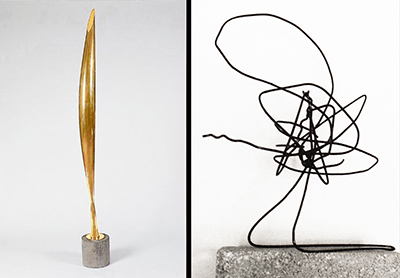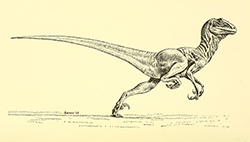MENU
The Electronic Scholarly Publishing Project: Providing access to classic scientific papers and other scholarly materials, since 1993. More About: ESP | OUR CONTENT | THIS WEBSITE | WHAT'S NEW | WHAT'S HOT
Comparative Timelines
The ESP Timeline (one of the site's most popular features) has been completely updated to allow the user to select (using the timeline controls above each column) different topics for the left and right sides of the display.
Select:
New Left Column
New Left Column
Dates
Decade
New Right Column
New Right Column
Alister Hardy promotes his Homo aquaticus or "aquatic ape" hypothesis to the British Sub Aqua Club. He will follow up this announcement with several magazine articles.
1960
(no entry for this year)
Gene Shoemaker and E.C.T. Chao publish a paper characterizing the Ries Basin in Bavaria as the result of a meteorite impact. This will help pave the way for eventual acceptance of asteroid and comet impacts as potential causes of mass extinction.

 F. Jacob and J. Monod publish "Genetic regulatory mechanisms in the synthesis of proteins," a paper in which the theory of the OPERON is developed.
F. Jacob and J. Monod publish "Genetic regulatory mechanisms in the synthesis of proteins," a paper in which the theory of the OPERON is developed.
Martin Glaessner determines fossils in the Ediacara Hills of South Australia (Ediacaran fauna) to be Precambrian in age (approximately 600 million years old), making them the oldest-known multicelled organisms.
1961
(no entry for this year)
Human geneticist James Neel develops the "thrifty genotype" hypothesis that human ancestors endured feast-famine cycles that made the human body very effective in storing fat for lean times.
1962
(no entry for this year)
Lantian Man, a 500,000-year-old Homo erectus specimen, is found in Lantian County, China, just north of Xi'an.
Fred Vine and Drum Matthews publish a paper describing magnetic stripes formed at ocean ridges. Their findings will pave the way for the acceptance of continental drift over the next decade.
1963
(no entry for this year)
Louis Leakey describes Homo habilis, meaning "handy." The new species designation is not well received by the scientific community.
Two deciduous molars, roughly 44,000 years old, are collected at Grotta del Cavallo in southeastern Italy. After an initial classification as Neanderthal, they will be assigned to modern humans in a 2011 study.
Vincent Dethier publishes "Microscopic Brains," an article on insect behavior, in Science. He calls for a more empathetic approach to animal subjects, even tiny invertebrates.
W. Brian Harland and Martin J. S. Rudwick publish a theory that the Earth experienced a great ice age in the Neoproterozoic (late Precambrian). Rudwick suggests that the climate's return to moderate conditions paved the way for the evolution of multicelluar life.
1964
 painting by Roy Lichtenstein: Oh, Jeff...I Love You, Too...But... (sometimes Oh, Jeff). Like many of Lichtenstein's works its title comes from the speech balloon in the painting. Although many sources, such as the Encyclopedia of Art, describe Whaam! and Drowning Girl as Lichtenstein's most famous works, artist Vian Shamounki Borchert believes it is this piece, calling it his Mona Lisa. The Daily Mail listed it along with Whaam! and Drowning Girl as one of his most famous at the time of its 2013 Retrospective at the Tate Modern. Borchert notes that this painting captures "the magic" of its "anguished and yes [sic] beautiful blue eyed, blond hair, full lips" female subject while presenting "sad eyes that seem to give in to what seems to be a doomed love affair". Lichtenstein in 1967 Measuring 48 in × 48 inches, Oh, Jeff...I Love You, Too...But... is among the most famous of his early romance comic derivative works from the period when he was adapting cartoons and advertisements into his style via Ben-Day dots.
painting by Roy Lichtenstein: Oh, Jeff...I Love You, Too...But... (sometimes Oh, Jeff). Like many of Lichtenstein's works its title comes from the speech balloon in the painting. Although many sources, such as the Encyclopedia of Art, describe Whaam! and Drowning Girl as Lichtenstein's most famous works, artist Vian Shamounki Borchert believes it is this piece, calling it his Mona Lisa. The Daily Mail listed it along with Whaam! and Drowning Girl as one of his most famous at the time of its 2013 Retrospective at the Tate Modern. Borchert notes that this painting captures "the magic" of its "anguished and yes [sic] beautiful blue eyed, blond hair, full lips" female subject while presenting "sad eyes that seem to give in to what seems to be a doomed love affair". Lichtenstein in 1967 Measuring 48 in × 48 inches, Oh, Jeff...I Love You, Too...But... is among the most famous of his early romance comic derivative works from the period when he was adapting cartoons and advertisements into his style via Ben-Day dots.
 An art exhibit is held at Stanford University, featuring Brancusi's Bird in Space (loaned by student Richard Holkar) as its major piece. Another work entitled Soul in Flight — a "sculpture" consisting of two bent coat hangers — is surreptitiously added to the exhibit by D. Heskett and R. Robbins (student colleagues of Holkar), without the bother of going through the submission process. The coat-hanger piece remains as part of the exhibit for several days, until it is accidentally bumped and comes apart during an evening cleaning of the displays.
An art exhibit is held at Stanford University, featuring Brancusi's Bird in Space (loaned by student Richard Holkar) as its major piece. Another work entitled Soul in Flight — a "sculpture" consisting of two bent coat hangers — is surreptitiously added to the exhibit by D. Heskett and R. Robbins (student colleagues of Holkar), without the bother of going through the submission process. The coat-hanger piece remains as part of the exhibit for several days, until it is accidentally bumped and comes apart during an evening cleaning of the displays.
N.H. Field publishes "Fossil sea-echinoids from a Romano-British site" describing the centuries-long occupation of a Romano-British settlement in Dorset. Newer buildings have been built upon older ones, with fossil urchins in each.
1965
(no entry for this year)
Willi Hennig works on a new approach to assessing evolutionary relationships, known as cladistics. Although it will be hotly debated, this technique will eventually become standard practice in paleontology, botany and zoology.
Harry Whittington begins reexamining Burgess Shale fossils originally identified by Charles Walcott starting in 1909. Over the next two decades, Whittington (with the assistance of his graduate students Simon Conway Morris and Derek Briggs), will eventually overturn some of Walcott's theories and propose that most of the animals left no living relatives.
1966
(no entry for this year)
Lynn Sagan (later Lynn Margulis) hypothesizes that chloroplasts originated as cyanobacteria, and that mitochondria originated as bacteria. She suggests that both were engulfed by other cells and began functioning as symbionts.
Graduate student S.B. Misra discovers a well-preserved sea floor with numerous fossils dating from the late Precambrian (later to be dubbed the Ediacaran Period) at Mistaken Point, Newfoundland.
P. S. Martin suggests that fast-moving bands of human hunters caused the extinctions of Pleistocene big-game species.
Richard Leakey finds two fossil skulls, Omo I and Omo II, in Ethiopia. Though initially dated at 130,000 years, the fossils will later be dated (using argon decay) at 195,000 years, and designated as the oldest examples so far found of Homo sapiens.
Daniel Janzen argues that, because they live under "easy" conditions, tropical plants cannot likely survive a wide range of temperature, light, or hydrologic conditions.
Surgeon General definitively links smoking to lung cancer and presents evidence that it is causing heart problems.
1967
(no entry for this year)
A.G. Cairns-Smith publishes a paper suggesting that the first life on Earth might have been fine-grained clay crystals. He will publish on this topic several more times before his death, but the experimental evidence will remain scant, perhaps in part because sufficient technology doesn't yet exist to test the hypothesis.
Richard Fox describes a Paleocene mammal, Prothryptacodon albertensis, retrieved from a well dug in Alberta, Canada. This find eerily resembles that of another Paleocene mammal recovered from a Louisiana oil well and described in 1932 by George Gaylord Simpson.
Teenaged fossil enthusiast Tadashi Suzuki finds a plesiosaur fossil in his hometown of Iwaki City, Japan. The fossil turns out to be a new species, but it won't be identified as such for nearly 40 years.
1968
(no entry for this year)
R. H. Whittaker proposes to divide all living things into five kingdoms: Animalia, Plantae, Fungi, Protista and Monera.
Archaeologist Joachim Hahn pieces together the fragments of the lion- headed man found 30 years earlier the Hohlenstein-Stadel Cave in Germany.
 John Ostrom publishes Osteology of Deinonychus antirrhopus, an Unusual Theropod from the Lower Cretaceous of Montana — a description of Deinonychus with a frontispiece illustration by Bob Bakker, suggesting that the dinosaur is alert, agile and intelligent.
John Ostrom publishes Osteology of Deinonychus antirrhopus, an Unusual Theropod from the Lower Cretaceous of Montana — a description of Deinonychus with a frontispiece illustration by Bob Bakker, suggesting that the dinosaur is alert, agile and intelligent.
Americans land the first man on the moon.
1969
(no entry for this year)
ESP Quick Facts
ESP Origins
In the early 1990's, Robert Robbins was a faculty member at Johns Hopkins, where he directed the informatics core of GDB — the human gene-mapping database of the international human genome project. To share papers with colleagues around the world, he set up a small paper-sharing section on his personal web page. This small project evolved into The Electronic Scholarly Publishing Project.
ESP Support
In 1995, Robbins became the VP/IT of the Fred Hutchinson Cancer Research Center in Seattle, WA. Soon after arriving in Seattle, Robbins secured funding, through the ELSI component of the US Human Genome Project, to create the original ESP.ORG web site, with the formal goal of providing free, world-wide access to the literature of classical genetics.
ESP Rationale
Although the methods of molecular biology can seem almost magical to the uninitiated, the original techniques of classical genetics are readily appreciated by one and all: cross individuals that differ in some inherited trait, collect all of the progeny, score their attributes, and propose mechanisms to explain the patterns of inheritance observed.
ESP Goal
In reading the early works of classical genetics, one is drawn, almost inexorably, into ever more complex models, until molecular explanations begin to seem both necessary and natural. At that point, the tools for understanding genome research are at hand. Assisting readers reach this point was the original goal of The Electronic Scholarly Publishing Project.
ESP Usage
Usage of the site grew rapidly and has remained high. Faculty began to use the site for their assigned readings. Other on-line publishers, ranging from The New York Times to Nature referenced ESP materials in their own publications. Nobel laureates (e.g., Joshua Lederberg) regularly used the site and even wrote to suggest changes and improvements.
ESP Content
When the site began, no journals were making their early content available in digital format. As a result, ESP was obliged to digitize classic literature before it could be made available. For many important papers — such as Mendel's original paper or the first genetic map — ESP had to produce entirely new typeset versions of the works, if they were to be available in a high-quality format.
ESP Help
Early support from the DOE component of the Human Genome Project was critically important for getting the ESP project on a firm foundation. Since that funding ended (nearly 20 years ago), the project has been operated as a purely volunteer effort. Anyone wishing to assist in these efforts should send an email to Robbins.
ESP Plans
With the development of methods for adding typeset side notes to PDF files, the ESP project now plans to add annotated versions of some classical papers to its holdings. We also plan to add new reference and pedagogical material. We have already started providing regularly updated, comprehensive bibliographies to the ESP.ORG site.
ESP Picks from Around the Web (updated 06 MAR 2017 )
Old Science

Weird Science

Treating Disease with Fecal Transplantation
Fossils of miniature humans (hobbits) discovered in Indonesia

Dinosaur tail, complete with feathers, found preserved in amber.
Astronomy

Mysterious fast radio burst (FRB) detected in the distant universe.